Article & photos by David Lawler, Consulting’ Geologist
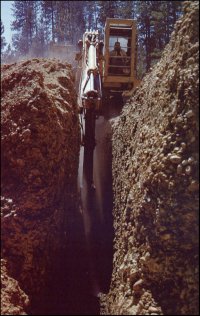 Placer gold deposits represent the most attractive targets for small-scale miners and prospectors, since activities can be carried out with reasonably small costs, and encouraging prospecting results can be obtained rapidly. A small-scale miner has the opportunity to exploit small, rich accumulations of gold which larger-sized mining companies might pass by, due to reserve-size and overall ore-grade. In other words, because of the higher costs involved with a larger mining company, they will not be interested in some types of gold deposits which can be quite lucrative for a smaller-scale mining program.
Placer gold deposits represent the most attractive targets for small-scale miners and prospectors, since activities can be carried out with reasonably small costs, and encouraging prospecting results can be obtained rapidly. A small-scale miner has the opportunity to exploit small, rich accumulations of gold which larger-sized mining companies might pass by, due to reserve-size and overall ore-grade. In other words, because of the higher costs involved with a larger mining company, they will not be interested in some types of gold deposits which can be quite lucrative for a smaller-scale mining program.
Placer deposits have been exploited by man since early historic times and have remained an important source of gold on the world market into the 20th Century.
Placer deposits have yielded over 60% of the world’s gold production. Placer gold production in California alone during the height of the Gold Rush has been estimated at $81 million dollars. (Dollar-value in terms of $18/ounce in 1849, prior to 150 years of inflation).
While many texts and articles have been written on the subject of placer mining, the purpose of this article is to provide a brief overview of the subject and to introduce relevant facts which have practical application for the small-scale miner. The less common types of placers, e.g., Glacial, Aeolian, Bajada and beach placers will not be covered in this article.
Alluvial Placer Gold Deposits
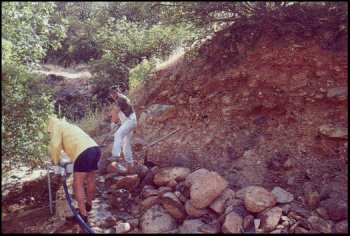 Definition: Alluvial deposits are the most common type of placer gold deposit. This category includes fluxial (river and stream) placers which formed in well-defined channels. It also includes “bench” or terrace deposits. These are older river or streambeds which formed on the elevated side slopes of drainage valleys. Both ancient (paleo placers) and modern deposits are included in this category and have produced significant amounts of gold.
Definition: Alluvial deposits are the most common type of placer gold deposit. This category includes fluxial (river and stream) placers which formed in well-defined channels. It also includes “bench” or terrace deposits. These are older river or streambeds which formed on the elevated side slopes of drainage valleys. Both ancient (paleo placers) and modern deposits are included in this category and have produced significant amounts of gold.
Characteristics: Good sorting of sediment and gold particles by size and weight.
Sediments tend to be well transported, reflecting significant rounding or flattening of individual particles as a function of distance traveled from its source. The source of gold can either originate from a nearby lode deposit, generally leaving the gold’s surface with a rough texture; or the gold can have originated from distant sources, generally leaving it with smooth, flattened particles, flakes or nuggets.
Ancient Fluvial Placer Deposits
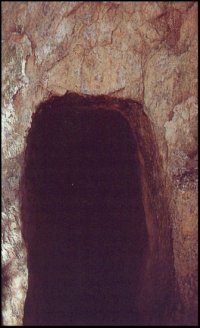 Examples: (Ancient) Tertiary-age Ancestral, Yuba and Feather River systems, Sierra Nevada Mountains, California, Ancestral Klamath River system, Weaverville and Hornbrook basins Klamath Mountains, California. There are also widespread occurrences of other ancient gold-bearing channels in other western states in the U.S.
Examples: (Ancient) Tertiary-age Ancestral, Yuba and Feather River systems, Sierra Nevada Mountains, California, Ancestral Klamath River system, Weaverville and Hornbrook basins Klamath Mountains, California. There are also widespread occurrences of other ancient gold-bearing channels in other western states in the U.S.
Prospecting Suggestions: Check areas where modem drainages (rivers, creeks, and gullies) have eroded ancient gold-bearing channel deposits. Many of these areas were worked by miners during the 19th Century, but there is still plenty of gold remaining for the modem-day small-scale miner.
For example, check side slopes of ridges which contain the ancient channel deposits, since these are areas that usually could not be exploited by hydraulic or ground-sluicing mine methods, due to lack of adequate water or water pressure. These virgin (unexploited) areas can produce eroded substantial pockets of placer gold.
Hydraulic Mine Pit areas often contain good prospects for small-scale mining. Check the exposed bedrock floor (representing the exhumed channel base) surfaces both for cracks and weathered cemented gravels. Gold may remain in small fractures and cracks in the bedrock. These areas can be particularly fruitful for electronic prospecting.
In addition, gold may be liberated from previously-cemented gravels after the long period of weathering on the pit floor. Check drain tunnels and tailraces that may have been cut into bedrock or the sides of the channel for several reasons: First, drain tunnels were driven through solid bedrock at the floor of a hydraulic pit to drain excess water and tailings from the working face of a mining excavation.
It is estimated that hydraulic mining methods lost between 30% – 50% of the gold that was liberated from the deposit. In addition, many of the drain tunnels were also used as the primary locations for the placement of elongated sluice box recovery systems. Thus, clean-ups were performed inside the tunnels. Although some of the drain tunnels have become choked with debris or collapsed from weathering, many still carry gold-bearing materials through the tunnels.
Testing and sampling of in-situ (in place) Tertiary gravel placers is one very proven method of locating valuable gold deposits for the serious small-scale mining operation today.
Modem Fluvial Placer Deposits
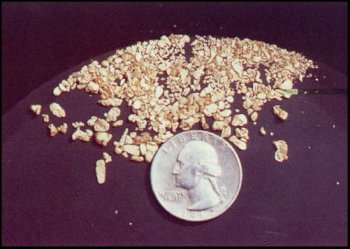 Examples: Rivers and streams of the Sierra Nevada and Klamath Mountain areas in California.
Examples: Rivers and streams of the Sierra Nevada and Klamath Mountain areas in California.
Prospecting Suggestions: Prospect areas which are adjacent to known ancient channels or lode gold deposits, since modern river deposits will usually become more enriched close to those areas.
Gold-bearing stream and river channels must be examined and studied in detail in regard to their history, habit and special characteristics, in order to better-exploit the placers contained in them. Check available geologic maps of a particular river area or observe the different bedrock types which are present. This information will yield valuable clues to the location and manner of gold accumulation in various stretches of river.
Most modern-day small-scale prospectors are using suction dredges, sluicing gear, vack-mining equipment and/or gold pans to prospect for and develop these types of gold deposits.
Sample bench deposits adjacent to the active stream margin. Although these deposits are not as commonly reworked by stream processes, they often contain high concentrations of placer gold. Thick bench deposits containing gold-bearing material derived from hydraulic mines are still present along the margins of rivers and streams in the Sierra Nevada and Klamath Mountain regions of California.
Residual Placer Deposits
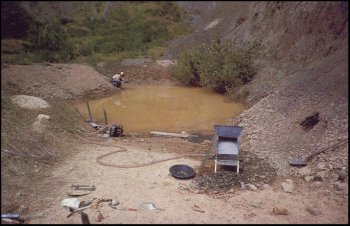 Definition: Shallow mineral deposits forming directly from weathering and chemical disintegration of a gold-bearing quality vein near the surface. Residual deposits tend to be rich, but localized in occurrence, i.e., close to the vein or outcrop area. These are also termed “seam diggings” due to their occurrence in weathered gold-bearing quartz stringers contained in weathered schist and slate fracture-zones.
Definition: Shallow mineral deposits forming directly from weathering and chemical disintegration of a gold-bearing quality vein near the surface. Residual deposits tend to be rich, but localized in occurrence, i.e., close to the vein or outcrop area. These are also termed “seam diggings” due to their occurrence in weathered gold-bearing quartz stringers contained in weathered schist and slate fracture-zones.
Examples: “Seam digging”s at Georgia Slide, Spanish Dry Diggings and French Hill areas, Georgetown Divide, El’Dorado County, California, Alleghany and Downieville districts, Sierra County, California, Humboldt Mountains area, Humboldt County, Nevada.
Prospecting Suggestions: Search in lode gold districts characterized by small high-grade gold-quartz vein pocket deposits. Focus your search into specific areas which are along the geologic trend of previously-exploited lode pocket deposits. Recent fires, landslides, or disturbance by logging operations are constantly exposing new virgin areas for prospecting.
Modern-day metal detectors may help in the exploration and exploitation of these deposits, due to shallow overburden and erratic distribution of the residual placer nuggets.
Eluvial (hill-slope) Placer Deposits
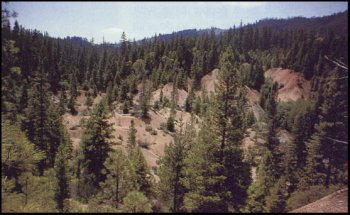 Definition: Deposits representing the transitional stages between a residual and alluvial placer deposit (deposits which form in route between the lode erosion and drainage system). Residual gold tends to form accumulations in soil or colluvium by “creeping” along with material down a hill-slope.
Definition: Deposits representing the transitional stages between a residual and alluvial placer deposit (deposits which form in route between the lode erosion and drainage system). Residual gold tends to form accumulations in soil or colluvium by “creeping” along with material down a hill-slope.
Examples: Klamath Mountain region, California and Oregon.
Prospecting Suggestions: A metal detector can be the ideal tool for locating these deposits, since gold distribution tends to be spotty or erratic due to a poor degree of sorting and transportation. High-banking equipment can be very productive where an adequate water source is available nearby. Dry-washing equipment can be productive in places where there is no water available for processing. Mechanized earth-moving equipment is sometimes necessary to excavate thick eluvial deposits. In this case, small wash plants are being used to recover the gold.
Recommended Reading
Averill C. v: 1946, Placer Mining for Gold in California: California Div. Mines Bull. 135, 377 p.
Clark, B. 1965, Tertiary Channels: California: Div. Mines and Geology Mineral Inf. Service, Z 18
Clark, B. 1970, Gold Districts of California: California Division of Mines Bull. 193, 186 p.
Haley, C.S., 1923, Gold Placers of California: California Mining Bur. Bull. 92, 167 p. Jenkins, O.P., 1946, Geology of Placer Deposits, in Averill, C. Z Placer Mining for Gold in California: California Div. Mines Bull. 135 p, p. 147-216.
Lindgren, 1911, The Tertiary Gravels of the Sierra Nevada of California: U.S. Geol. Survey Prof. Paper 73, 226 p.
Whitney, J.D., 1880, The Auriferous Gravels of the Sierra Nevada of California: Harvard Coll. Mus. Comp. Zoology Mem. v. 6, no 1, 569p.
- Here is where you can buy a sample of natural gold.
- Here is where you can buy Gold Prospecting Equipment & Supplies.
- More about gold prospecting
- Schedule of upcoming events
- Books and Videos by Dave McCracken.





